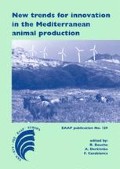Abstract
The aim of this study was to propose some alternatives to simplify a sheep MOET program looking at hormonal reduction, cost-effective and less time consuming treatments. Twenty-nine animals were divided into 3 groups: natural oestrus (NT) (n=10), double cloprostenol injection (DC) by 7 days apart (n=10) and double sponge (DS) 40 mg FGA for 14 days; the sponge was replaced by a new one, maintained from day 7 to 14 (n=9) as a control group; 350 I.U. of porcine FSH per sheep was administered in eight decreasing doses twice daily starting on day 4 after onset of oestrus (day 0) in the NT group and 48 h before second cloprostenol injection or sponge removal in the DC and DS groups respectively. A single dose of 125 μg cloprostenol was injected at the same time of first FSH dose in the DS group and on day 6 after oestrus in the NT group to induce luteolysis. All ewes were naturally mated 24 h after cloprostenol injection or sponge removal. Embryos were recovered surgically by flushing at Day 7 after mating. Among all recovered embryos (NT+DC+DS) 129 were vitrified, but only 22 vitrified and 20 fresh embryos from NT group were transferred in pair into 21 synchronised natural oestrus recipients using a direct transfer technique with the help of open pulled straw (OPS). Corpora lutea (CL), embryos recovered (ER), embryos fertilized (EF) and high quality embryos (EQ1) per ewe were analysed by ANOVA; while recovery (RR), fertility (FR), embryo quality (Q1R) rates by Chi Square analysis; lambing rate (LR) of fresh and vitrified embryos was similarly analysed. No statistical differences were founded between NT, DC and DS groups in the number of CL/ewe (10.7±3.4, 8.8±5.9, 7.6±5.1), ER/ewe (7.2±3.9, 5.0±6.6, 4.7±4.1 ), EF/ ewe (7.2±3.9, 5.0±6.6, 3.0±3.7), EQ/ewe (6.2±3.8, 4.5±6.5, 2.6±3.6), RR% (67.2, 56.8, 62.0) and QjR% (86, 90, 88) respectively. However, statistical differences were founded on FR% (100, 100, 62) between NT, DC and DS groups respectively. LR after transfer was similar for vitrified (59%) and fresh (60%) NT embryos. Results suggest the suitability of natural oestrus and cloprostenol for simplify some steps during a MOET program in alternative to traditional protocols avoiding intravaginal sponges, reducing costs and length of treatments.
Access this chapter
Tax calculation will be finalised at checkout
Purchases are for personal use only
References
Dattena, M., C. Accardo, S. Pilichi, V. Isachenko, L. Mara, B. Chessa and P. Cappai, 2004. Comparison of different vitrification protocols on viability after transfer of ovine blastocysts in vitro produced and in vivo derived. Theriogenology 62: 481-493.
Isachenko V., J.L. Alabart, M. Dattena, F. Nawroth, P. Cappai, E. Isachenko, M. J. Cocero, J. Olivera, A. Roche, C. Accardo, A. Krivokharchenko and J. Folch, 2003. New technology for vitrification and field (microscope-free) warming and transfer of small ruminant embryos. Theriogenology 59: 1209-1218.
Mayorga, I., F. Masia, L. Mara, F. Chessa, S. Casu, N. Juyena and M. Dattena, 2008. Superovulation fsh-p protocol in sarda ewes without progestagen synchronization treatment. Reprod. Dom. Anim. 43: suppl 3-pag. 193 (abstract).
Menchaca A., M. Vilarino, M. Crispo, A. Pinczak and E. Rubianes, 2007. Day 0 Protocol: Superstimulatory treatment initiated in the absence of a large follicle improve ovarian response and embryo yield in goats. Theriogenology 68: 1111-1117.
Niemann, H., E. Schilling, B. Sacher, D. Smidt, 1981. Der FDA - and DAPPI-TEST; Ein Beitrag zur Vitalitatsbeurteilung von Rinderembryonen mit Hilfe der flureszenzmikrokopie Berel. Muh. Tierarztl. Wochenschr 9: 441-445.
Vajta, G., P. Holm, M. Kuwayam, P. J. Booth, H. Jacobsen, T. Greve and H. Callesen, 1998. Open-Pulled Straw (OPS) vitrification: a new way to reduce cryoinjuries of bovine ova and embryos. Mol. Reprod. Dev. 51: 53-58.
Yang, N.S., K. H. Lu, I. Gordon and C. Polge. 1992. Vitrification of bovine blastocysts produced in vitro. Theriogenology 37:326 (abstract).
Author information
Authors and Affiliations
Editor information
Rights and permissions
Copyright information
© 2012 Wageningen Academic Publishers
About this chapter
Cite this chapter
Mayorga, I., Masia, F., Mara, L., Casu, S., Dattena, M. (2012). Proposal of some alternatives to simplify a MOET programme. In: Bouche, R., Derkimba, A., Casabianca, F. (eds) New trends for innovation in the Mediterranean animal production. EAAP – European Federation of Animal Science, vol 129. Wageningen Academic Publishers, Wageningen. https://doi.org/10.3920/978-90-8686-726-4_9
Download citation
DOI: https://doi.org/10.3920/978-90-8686-726-4_9
Publisher Name: Wageningen Academic Publishers, Wageningen
Online ISBN: 978-90-8686-726-4
eBook Packages: Biomedical and Life SciencesBiomedical and Life Sciences (R0)


